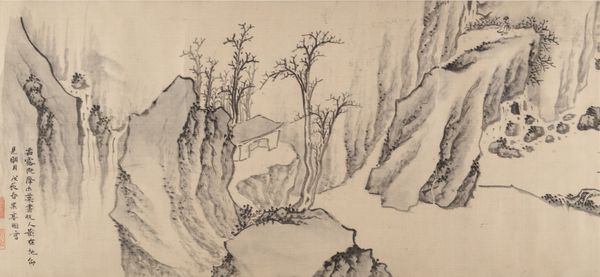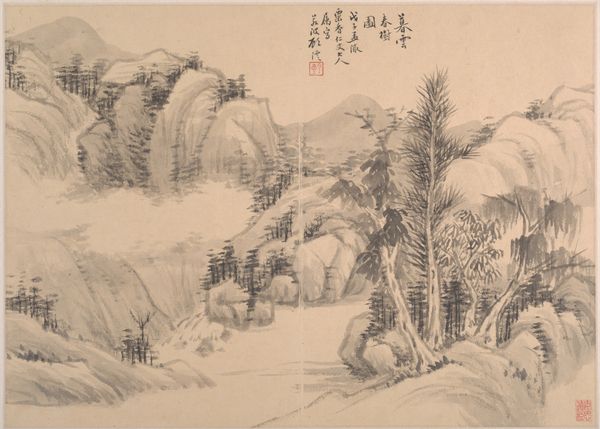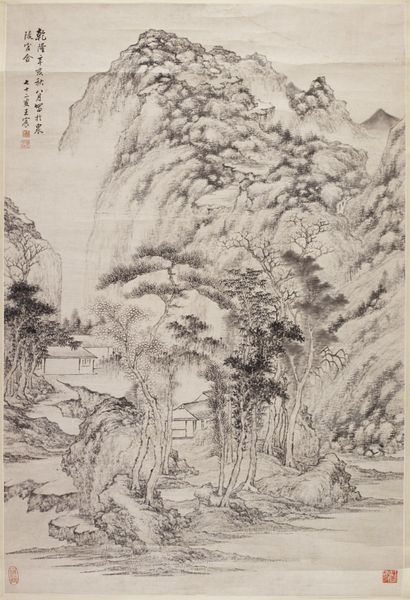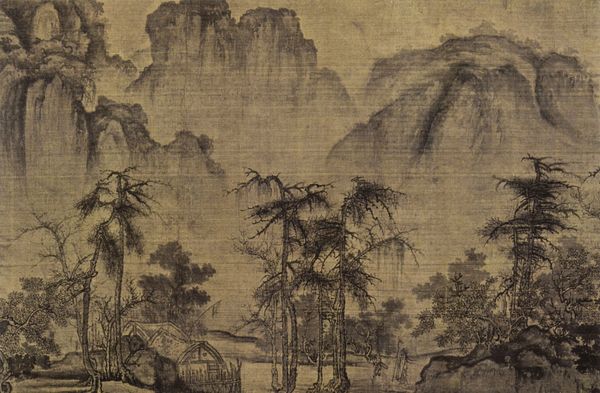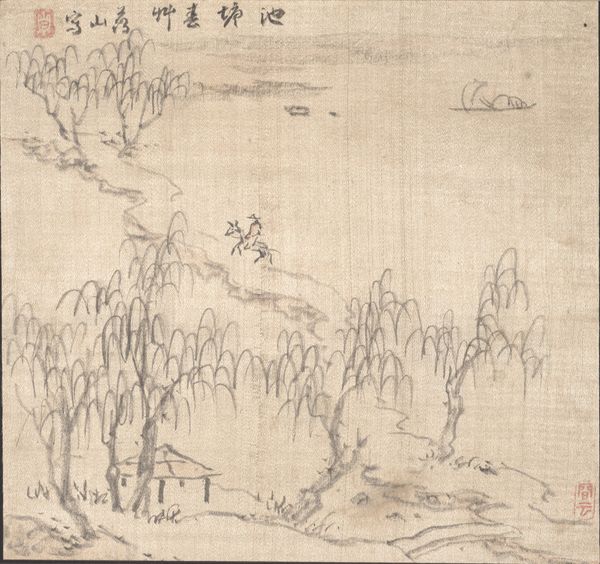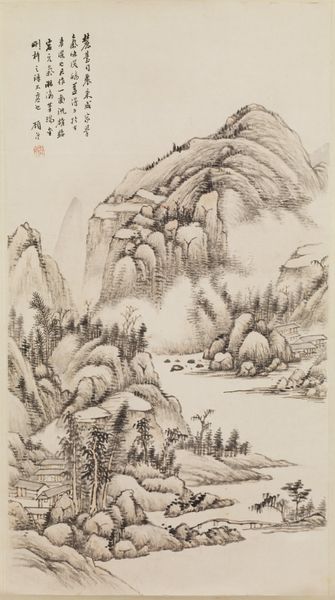
drawing, paper, ink-on-paper, ink, mural
#
drawing
#
asian-art
#
landscape
#
paper
#
ink-on-paper
#
ink
#
mural
Dimensions: 16 7/16 x 13 3/16 in. (41.75 x 33.5 cm) (image)19 3/4 x 15 5/16 in. (50.17 x 38.89 cm) (leaf, overall)19 15/16 x 15 15/16 x 1 1/4 in. (50.6 x 40.5 x 3.2 cm) (entire album, overall, closed)
Copyright: Public Domain
Curator: Just looking at this drawing, "Album Leaf" from 1774 by Wang Chen, I feel this compelling sense of yearning, of aspiring towards something just out of reach. Editor: It’s fascinating how the use of ink on paper can convey so much detail and depth! This piece at the Minneapolis Institute of Art shows a landscape with meticulous precision, echoing the literati tradition of landscape painting during the Qing dynasty. Curator: Exactly. See how these towering peaks evoke feelings of reverence and challenge. The architecture nestled high up, accessible only by winding paths, signifies a spiritual ascent, doesn't it? Are these the homes of sages, scholars, perhaps immortals? Editor: Or even symbols of Imperial power. I see how the composition invites viewers to imagine navigating this terrain, literally climbing the social ladder, or entering exclusive circles that demanded high culture. There is so much political reality tied up in these sorts of imagined ideal spaces. Curator: The cultural memory embedded here is undeniable. Look at the repetitive motifs of rocks and trees rendered in wash. These recall ancient models, carrying within them centuries of contemplation of humanity's place within nature. It evokes serenity but also points to isolation. Editor: Which might reflect Wang Chen's own social and professional positioning during that time, but let’s not romanticize. A scholar-official was bound by duty and often embroiled in factional politics at the imperial court. The imagery allows for a temporary escape but within firm boundaries of social and political constraint. Curator: I concede the point about boundaries. Yet I can’t help but respond to the sense of seeking harmony. What the architecture adds to the scenery reflects a utopian vision, a symbolic language expressing harmony and balance that extends to us across the centuries. Editor: Yes, perhaps utopia viewed through a very particular lens – of class and imperial aspiration. But ultimately the appeal for the modern viewer lies in these layers of meaning that reveal Wang Chen's complex role as both artist and public figure. Curator: For me it evokes echoes that lead into personal quests, while understanding its context. It’s an enduring, evolving set of symbolic prompts. Editor: Absolutely. We can still appreciate that tension between individual longing and larger societal structures that makes this image so potent, across historical distance and personal viewpoints.
Comments
minneapolisinstituteofart almost 2 years ago
⋮
Born in Kiangsu province, Wang Ch'en was a descendant of the great literatus Wang Shih-min and a great grandson of the artist Wang Yuan-ch'i. He served for a while in the Grand Secretariat and as a prefect in Hunan province. Wang's illustrious family heritage strengthened his reputation as an orthodox painter and he is one of the so-called Four Minor Wangs of the later Ch'ing. Wang's inscriptions here indicate that the basis for this album of large landscapes was the natural scenery of Ch'u, a Warring States (480-221 BCE) kingdom located south of the Yangtze River. In 1774, Wang was serving as a low-level official in this region. His inscriptions also mention earlier poets and painters whose conceptual and stylistic influences along with natural scenery inspired the various scenes here, which were based on sketches made at the sites themselves. The inscriptions read: 1) The landscape of Ch'u is extremely scenic. I came across one place and sketched it but neglected to ask its name. 2) One morning I entered the sea in search of Li Po; looking in vain among the paintings of mere mortals for the "Immortal of Ink." 3) The ceremonial burial mounds and Szechuan are neat. This is a scene of entering the gorge. 4) I have used the brushwork of Shu-ming (Wang Meng) to paint the style of Old Man Sung-hsueh (Chao Meng-fu). There is resemblance because they are from the same family.
Join the conversation
Join millions of artists and users on Artera today and experience the ultimate creative platform.
